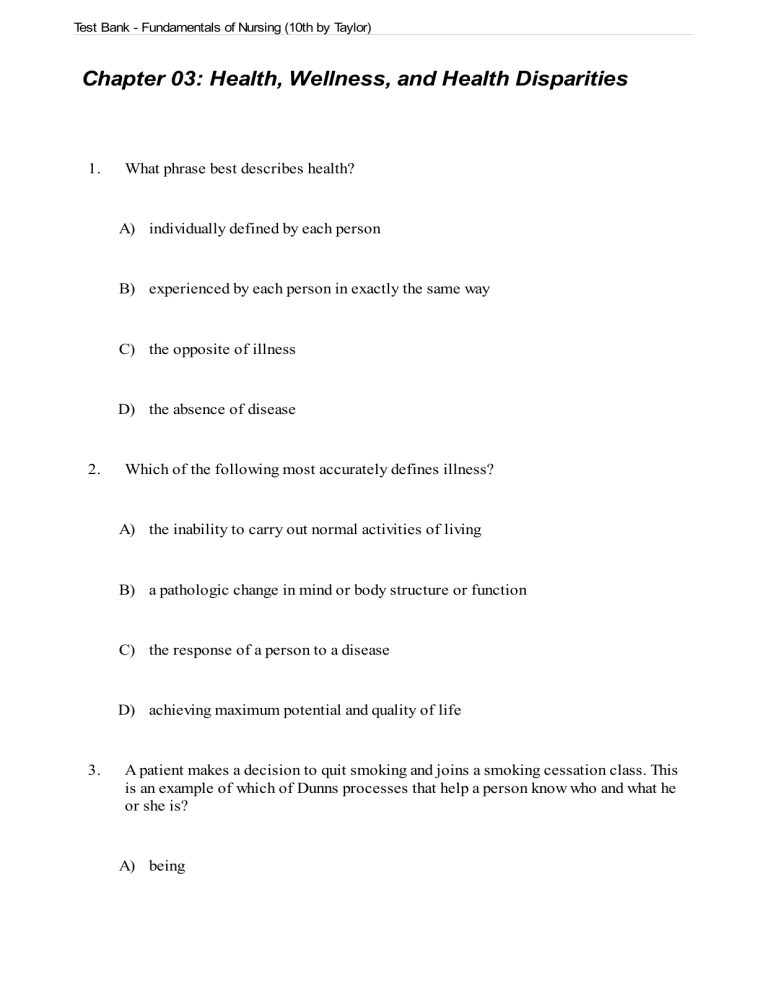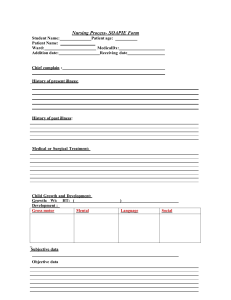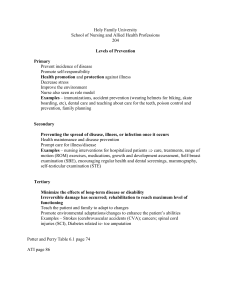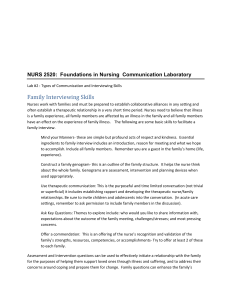
Test Bank - Fundamentals of Nursing (10th by Taylor) Chapter 03: Health, Wellness, and Health Disparities 1. What phrase best describes health? A) individually defined by each person B) experienced by each person in exactly the same way C) the opposite of illness D) the absence of disease 2. Which of the following most accurately defines illness? A) the inability to carry out normal activities of living B) a pathologic change in mind or body structure or function C) the response of a person to a disease D) achieving maximum potential and quality of life 3. A patient makes a decision to quit smoking and joins a smoking cessation class. This is an example of which of Dunns processes that help a person know who and what he or she is? A) being Test Bank - Fundamentals of Nursing (10th by Taylor) B) belonging C) becoming D) befitting 4. Which of the following statements accurately describes the concepts of disease and illness? A) A disease is traditionally diagnosed and treated by a nurse. B) The focus of nurses is the person with an illness. C) A person with an illness cannot be considered healthy. D) Illness is a normal process that affects level of functioning. 5. A rapid onset of symptoms that last a relatively short time indicates what health problem? A) a chronic illness B) an acute illness C) actual risk factor D) potential for wellness Test Bank - Fundamentals of Nursing (10th by Taylor) 6. A nurse caring for patients with diabetes knows that the following is a characteristic of a chronic illness: A) It is a temporary change. B) It causes reversible alterations in A&P. C) It requires special patient education for rehabilitation. D) It requires a short period of care or support. 7. What manifestation is the most significant symptom indicating an illness? A) bleeding B) runny nose C) pain D) itching 8. A nurse calls in to his unit to report he has the flu and will not be at work. What stage of illness behavior is he exhibiting? A) experiencing symptoms B) assuming the sick role Test Bank - Fundamentals of Nursing (10th by Taylor) C) assuming a dependent role D) achieving recovery and rehabilitation 9. A patient accepts the fact that he needs bypass surgery for a blocked artery and is admitted into the hospital. Which one of the following stages of illness is this patient experiencing? A) Stage 1 B) Stage 2 C) Stage 3 D) Stage 4 10. Which of the following is an example of a characteristic of the Stage 2 of illness? A) A person tells his family that he is sick and allows them to take care of him. B) A person experiences a headache and sore throat and takes an aspirin. C) A person visits a physician to receive treatment for symptoms of an infection. D) A person begins rehabilitation following a stroke that left him paralyzed on one side. 11. A 4-year-old child has leukemia but is now in remission. What does it mean to be in remission when one has a chronic illness? Test Bank - Fundamentals of Nursing (10th by Taylor) A) The chronic disease has been cured. B) Nothing further can be done in terms of treatment. C) Severe symptoms of the chronic illness have reappeared. D) The disease is present, but symptoms are not experienced. 12. What may happen to the family when an illness occurs in one of the family members? A) alterations in values and religious beliefs B) more public displays of affection C) changes in roles for the patient and family D) increased resistance to stress 13. A baby is born with Down syndrome, which influences his healthillness status. This is an example of which of the following human dimensions? A) Physical B) Emotional C) Environmental Test Bank - Fundamentals of Nursing (10th by Taylor) D) Sociocultural 14. Which of the following is an example of the sociocultural dimension influencing a persons healthillness status? A) A family lives in a city environment where the air pollution levels are high. B) A father who is a practicing Jehovahs Witness refuses a blood transfusion for his son. C) A teenager who was in an automobile accident worries that his scars will cause him to lose friends. D) A single mother of two applies for food stamps in order to feed her family. 15. A nurse is caring for a 17-year-old female patient whose left leg was amputated after being crushed in a motor vehicle accident. Which of the following interventions might the nurse perform to accommodate the patients intellectual dimension? A) considering the patients developmental stage when planning nursing care B) encouraging friends and relatives to visit often and bring games to distract her C) teaching her how to care for the stump and explaining the rehabilitation program D) providing the opportunity for a counselor to come in and talk to her about her loss Test Bank - Fundamentals of Nursing (10th by Taylor) 16. Which of the following statements accurately describe how risk factors may increase a persons chances for illness or injury? Select all that apply. A) Risks factors are unrelated to the person or event. B) All risk factors are modifiable. C) An increase in risk factors increases the possibility of illness. D) A family history of breast cancer is not a modifiable risk factor. E) School-aged children are at high risk for communicable diseases. F) Multiple sexual relationships increase the risk for sexually transmitted diseases. 17. Which of the following nursing interventions are examples of health promotion and preventive care on the primary level? Select all that apply. A) A nurse counsels a teenager to stop smoking. B) A nurse conducts a health fair for high blood pressure screening. C) A nurse counsels the family of a patient diagnosed with lung cancer. D) A home healthcare nurse arranges for rehabilitation services for a patient. E) A school nurse arranges for a career seminar for graduating seniors. Test Bank - Fundamentals of Nursing (10th by Taylor) F) A nurse devises a low-calorie diet for an obese teenager. 18. Which of the following topics is important when teaching teens and young adults? A) safer sex practices B) blood pressure control C) immunization for measles D) effective hand hygiene 19. Which of the following statements illustrates the effect of the sociocultural dimension on health and illness? A) Why shouldnt I drink and drive? Everyone else does. B) My mother has sickle cell anemia, and so do I. C) I know I have heart problems, so I have changed my diet. D) I used biofeedback to lower my blood pressure. 20. A middle-aged woman is 40 pounds over her ideal weight. Which of the following statements best illustrates the effect of her self-concept on health and illness? A) I am just too busy with my kids to bother about a diet. Test Bank - Fundamentals of Nursing (10th by Taylor) B) Why should I lose weight? Ill still be fat. C) My sister is thin, but I dont think she looks that good. D) My husband loves me this way. 21. A camp nurse is teaching a group of adolescent girls about the importance of monthly breast self-examination. What level of preventive care does this activity represent? A) primary B) secondary C) tertiary D) restorative 22. On which of the following components is Rosenstocks health belief model based? Select all that apply. A) perceived susceptibility to a disease B) perceived consequences of treating disease C) perceived seriousness of a disease D) perceived benefits of action Test Bank - Fundamentals of Nursing (10th by Taylor) E) perceived immunity to disease F) perceived benefits of health insurance 23. A nurse refers a 67-year-old male patient to group counseling for alcohol cessation. According to Rosenstocks health belief model, the patients knowledge of the diseases that may occur with alcoholism is a: A) demographic variable B) sociopsychological variable C) structural variable D) intellectual variable 24. Which of the following models of health promotion and illness prevention was developed to illustrate how people interact with their environment as they pursue health? A) the health promotion model B) the health belief model C) the healthillness continuum D) the agenthostenvironment model Test Bank - Fundamentals of Nursing (10th by Taylor) 25. Which of the following factors constitute the environment component of the agenthostenvironment model of health and illness (Leavell and Clark, 1965)? Select all that apply. A) bacteria/viruses B) chemical substances C) health habits D) family history E) cultural factors F) biologic factors 26. Nurses use new resources for healthcare practices to promote health and serve as an advocate for patients and families in all settings. Which one of the following resources has been most instrumental in improving access to care for people living in rural or underserved areas of the nation? A) telehealth practice B) industrial programs C) community centers D) nontraditional healthcare sites Test Bank - Fundamentals of Nursing (10th by Taylor) 27. Which of the following statements explain why models of health promotion and illness prevention are useful when planning healthcare? Select all that apply. A) They help healthcare providers understand health-related behaviors. B) They are useful for adapting care to people from diverse backgrounds. C) They help overcome barriers related to increased number of people without healthcare. D) They overcome barriers to care for the predicted downward trend in minority populations. E) They overcome barriers to care for low-income and rural populations. F) They explain why people take advantage of low-cost screens and healthcare information. 28. What is the nurses primary role in promoting health? A) educating others about health promotion activities B) avoiding smoking or drinking in public C) being a role model for health promotion D) implementing stress reduction activities Answer Key Test Bank - Fundamentals of Nursing (10th by Taylor) 1. A 2. C 3. D 4. B 5. B 6. C 7. C 8. B 9. C 10. A 11. D 12. C 13. A 14. D Test Bank - Fundamentals of Nursing (10th by Taylor) 15. C 16. C, D, E, F 17. A, F 18. A 19. A 20. B 21. A 22. A, C, D 23. C 24. A 25. E, F 26. A 27. A, B, C, E 28. C


